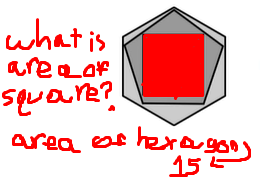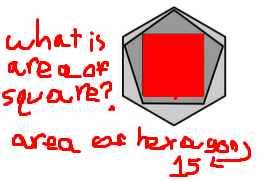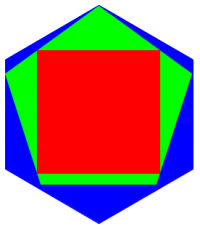You are using an out of date browser. It may not display this or other websites correctly.
You should upgrade or use an alternative browser.
You should upgrade or use an alternative browser.
Area of a square inside of a pentagon inside of a hexagon, and hexagons area is 15
- Thread starter ahsanboi
- Start date
D
Deleted member 4993
Guest
Are those regular hexagon and pentagon?What is the area of a square inside of a pentagon inside of a hexagon, and hexagons area is 15.
View attachment 29707I want to find area of the red square and the area of the hexagon is 15.
Please show us what you have tried and exactly where you are stuck.
Please follow the rules of posting in this forum, as enunciated at:
Please share your work/thoughts about this problem.

yes those are regular hexagons and pentagons, and i dont know what to do and im stuck on finding the area of pentagon and square cuz i don't know much on geometryAre those regular hexagon and pentagon?
Please show us what you have tried and exactly where you are stuck.
Please follow the rules of posting in this forum, as enunciated at:
Please share your work/thoughts about this problem.
D
Deleted member 4993
Guest
Define "circumcenter" according to your textbook?yes those are regular hexagons and pentagons, and i dont know what to do and im stuck on finding the area of pentagon and square cuz i don't know much on geometry
idk circumcenter meansDefine "circumcenter" according to your textbook?
Dr.Peterson
Elite Member
- Joined
- Nov 12, 2017
- Messages
- 16,869
What is the area of a square inside of a pentagon inside of a hexagon, and hexagons area is 15.
View attachment 29707I want to find area of the red square and the area of the hexagon is 15.
Where did this problem come from, if not from a geometry (or trigonometry?) textbook you are currently studying? The context should tell us something about what to expect, and should also teach you whatever you need to know to solve it.yes those are regular hexagons and pentagons, and i dont know what to do and im stuck on finding the area of pentagon and square cuz i don't know much on geometry
And why is it described so inadequately? "Inside of" doesn't specify the relationship. We can talk about one figure being inscribed in another, meaning that the former's vertices are on the latter's edges, with the former typically as large as possible; the picture looks almost like that, but not quite. The picture looks even less like they have the same circumcenter.
With no words explaining in what sense each figure is "inside of" the next, we have to depend on the picture too much.
Here is a slightly better picture of the arrangement as I understand it:
It is a square that is inscribed in a pentagon that is inscribed in a hexagonWhere did this problem come from, if not from a geometry (or trigonometry?) textbook you are currently studying? The context should tell us something about what to expect, and should also teach you whatever you need to know to solve it.
And why is it described so inadequately? "Inside of" doesn't specify the relationship. We can talk about one figure being inscribed in another, meaning that the former's vertices are on the latter's edges, with the former typically as large as possible; the picture looks almost like that, but not quite. The picture looks even less like they have the same circumcenter.
With no words explaining in what sense each figure is "inside of" the next, we have to depend on the picture too much.
Here is a slightly better picture of the arrangement as I understand it:
blamocur
Elite Member
- Joined
- Oct 30, 2021
- Messages
- 3,223
The square is indeed inscribed in the pentagon, but the pentagon is not inscribed in the hexagon -- you can see that the bottom two vertices of the pentagon are not on the edges of the hexagon, just near it. But the fact that the top vertices of the pentagon and the hexagon coincide, and two other pentagon's vertices are on the horizontal edges of the hexagon defines the pentagon uniquely (it's all about the degrees of freedomIt is a square that is inscribed in a pentagon that is inscribed in a hexagon
This raises an interesting question: can a regular pentagon be inscribed in a regular hexagon? What about a general case of two regular polygons?
Dr.Peterson
Elite Member
- Joined
- Nov 12, 2017
- Messages
- 16,869
In order to help you work this out, we really need to know what you have learned.It is a square that is inscribed in a pentagon that is inscribed in a hexagon
I'd almost certainly approach it with trigonometry. It's fairly easy to see how to find the points where the pentagon contacts the hexagon (essentially using the slopes of their respective sides). Finding the square seems considerably harder.
Again, where does the problem come from? Why do you think you are capable of solving it with your self-described lack of knowledge?
Here is one way:This raises an interesting question: can a regular pentagon be inscribed in a regular hexagon?

The area of a regular hexagon is one square meter. If you put a regular pentagon inside the hexagon, what is the maximum area the pentago...
Answer: Here’s the illustration of the problem : Area of hexagon = 1 sq m From the formula for an Area of a hexagon, Let’s find first the length of hexagon’s side, a. a = sqrt( (2 * A) / (3 * sqrt(3)) ) a = sqrt ( (2 * 1) / (3 * sqrt(3)) ) a = sqrt(2 / 5.19615) a = 0.6204 m Based from the...


